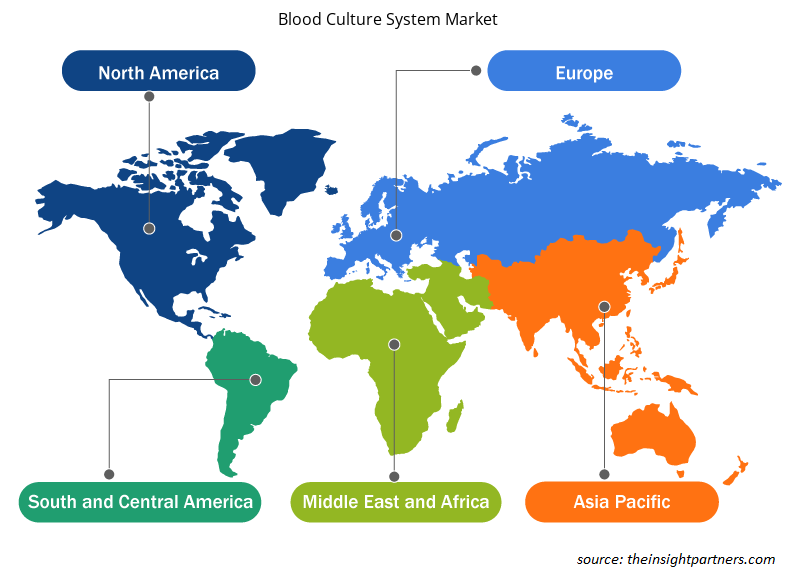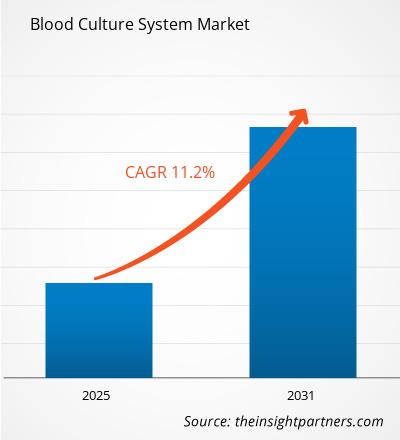من المتوقع أن يسجل سوق نظام زراعة الدم معدل نمو سنوي مركب بنسبة 11.2٪ من عام 2023 إلى عام 2031، مع توسع حجم السوق من XX مليون دولار أمريكي في عام 2023 إلى XX مليون دولار أمريكي بحلول عام 2031.
تم تقسيم التقرير حسب المنتج (المواد الاستهلاكية، الأجهزة)، والتكنولوجيا (التقنيات القائمة على الثقافة، والتكنولوجيات الجزيئية، والتكنولوجيات البروتينية). كما يقدم التقرير تحليلاً يعتمد على التطبيق (بكتيريا الدم، وفطريات الدم، والبكتيريا الفطرية). كما تم تقسيم التحليل العالمي على المستوى الإقليمي والدول الرئيسية. ويقدم التقرير القيمة بالدولار الأمريكي للتحليل والقطاعات المذكورة أعلاه.
غرض التقرير
يهدف تقرير سوق نظام زراعة الدم الصادر عن The Insight Partners إلى وصف المشهد الحالي والنمو المستقبلي وأهم العوامل الدافعة والتحديات والفرص. سيوفر هذا رؤى لمختلف أصحاب المصلحة في الأعمال التجارية، مثل:
- مزودي/مصنعي التكنولوجيا: لفهم ديناميكيات السوق المتطورة ومعرفة فرص النمو المحتملة، وتمكينهم من اتخاذ قرارات استراتيجية مستنيرة.
- المستثمرون: إجراء تحليل شامل للاتجاهات فيما يتعلق بمعدل نمو السوق، وتوقعات السوق المالية، والفرص المتاحة عبر سلسلة القيمة.
- الهيئات التنظيمية: لتنظيم السياسات ومراقبة الأنشطة في السوق بهدف تقليل الانتهاكات والحفاظ على ثقة المستثمرين ودعم سلامة السوق واستقرارها.
تجزئة سوق نظام زراعة الدم
منتج
- المواد الاستهلاكية
- الآلات الموسيقية
تكنولوجيا
- التقنيات القائمة على الثقافة
- التقنيات الجزيئية
- تقنيات التحليل البروتيني
طلب
- بكتيريا الدم
- فطريات الدم
- البكتيريا الفطرية
الجغرافيا
- أمريكا الشمالية
- أوروبا
- آسيا والمحيط الهادئ
- أمريكا الجنوبية والوسطى
- الشرق الأوسط وأفريقيا
الجغرافيا
- أمريكا الشمالية
- أوروبا
- آسيا والمحيط الهادئ
- أمريكا الجنوبية والوسطى
- الشرق الأوسط وأفريقيا
قم بتخصيص هذا التقرير ليناسب متطلباتك
ستحصل على تخصيص لأي تقرير - مجانًا - بما في ذلك أجزاء من هذا التقرير، أو تحليل على مستوى الدولة، وحزمة بيانات Excel، بالإضافة إلى الاستفادة من العروض والخصومات الرائعة للشركات الناشئة والجامعات
- احصل على أهم اتجاهات السوق الرئيسية لهذا التقرير.ستتضمن هذه العينة المجانية تحليلاً للبيانات، بدءًا من اتجاهات السوق وحتى التقديرات والتوقعات.
عوامل نمو سوق نظام زراعة الدم
- زيادة انتشار الاضطرابات المعدية: تزيد الاضطرابات المعدية، مثل عدوى مجرى الدم والإنتان، من الطلب على أنظمة زراعة الدم، مما يؤدي إلى نمو السوق. جنبًا إلى جنب مع تقدم أساليب التشخيص السريع، يتجه المتخصصون في الرعاية الصحية نحو الدقة في التشخيص، وبالتالي، تزداد الحاجة إلى أنظمة زراعة الدم المتقدمة بمرور الوقت مما يؤدي في النهاية إلى العلاج المناسب وتحسين النتائج للمرضى.
- الابتكارات التقنية: تعززت هذه السوق بفضل الابتكارات في تكنولوجيا زراعة الدم، بما في ذلك الأنظمة الآلية وتقنيات الكشف المتقدمة. وقد حدث تحسن كبير في الحساسية والوقت اللازم للكشف عن مسببات الأمراض، وكل هذا أدى إلى تسريع التشخيص والعلاج في بيئات الرعاية الحرجة وفتح المجال أمام قدرات المختبرات.
- التوعية بالإنتان: إن زيادة المعرفة بالإنتان وارتفاع معدل الوفيات الحادة يشجع أيضًا المزيد من مبادرات الرعاية الصحية للتركيز على الاكتشاف المبكر والعلاج. اعتبر الأطباء أن اختبار زراعة الدم في الوقت المناسب أمر لا غنى عنه في إدارة الإنتان، وبالتالي، فهم في وضع جيد لخلق طلب متزايد في السوق على أنظمة زراعة الدم الموثوقة ودعم النمو.
الاتجاهات المستقبلية لسوق نظام زراعة الدم
- الاتجاه المتزايد نحو الأتمتة: الاتجاه الناشئ في سوق أنظمة زراعة الدم هو الأتمتة. تستمر عملية أنظمة زراعة الدم الآلية في معالجة الإنتاجية المتزايدة، وتقليل الأخطاء البشرية، والحصول على نتائج أسرع. يشير هذا الاتجاه إلى الطلب الأكبر في صناعة الرعاية الصحية على الكفاءة والدقة في عمليات التشخيص.
- تكامل أنظمة المعلومات المخبرية: ترتبط أنظمة زراعة الدم بشكل وثيق بأنظمة المعلومات المخبرية. يؤدي ربط الأنظمة إلى زيادة كفاءة إدارة البيانات وسير العمل، وتحسين تتبع العينات، ومشاركة النتائج في الوقت الفعلي، والتنسيق بين المختبرات والفرق السريرية، وبالتالي رعاية المرضى بشكل جيد.
- التركيز على التشخيص السريع: يتزايد الطلب على زراعة الدم مع التركيز المتزايد على قدرات التشخيص السريع. ويتجه الطلب الحالي نحو استخدام التقنيات التي تحقق نتائج أسرع، بما في ذلك التشخيص الجزيئي والتسلسل الجيني للجيل التالي. ويعود هذا إلى الحاجة الملحة إلى اتخاذ قرار علاجي في حالات الطوارئ والرعاية الحرجة.
فرص سوق نظام زراعة الدم
- التوسع في الأسواق الناشئة: توفر سوق أنظمة زراعة الدم فرصًا أيضًا في الاقتصادات الناشئة، حيث يتم تطوير البنية الأساسية للرعاية الصحية. كما تتزايد الاستثمارات في التشخيصات المختبرية في الأسواق الناشئة، ويؤدي انتشار الأمراض المتزايد في هذه البلدان إلى زيادة الطلب على أنظمة زراعة الدم المتطورة، والتي ستكون مسار النمو للشركات المصنعة التي تسعى إلى تعزيز بصمتها العالمية.
- ظهور تقنيات الجيل القادم: هناك الكثير من الفرص لتطوير الجيل القادم من تقنيات زراعة الدم بحساسية وسرعة متزايدة. ومن المتوقع أن تحدث تقنيات مثل الاختبارات المتعددة وأنظمة الكشف الآلي ثورة في تشخيص العدوى وستلبي الطلب المرتفع من البيئات السريرية على حلول الاختبار السريعة والدقيقة.
- التعاون والشراكات: ستثبت التعاونات والشراكات الاستراتيجية بين شركات التشخيص ومقدمي الرعاية الصحية ومؤسسات البحث في سوق زراعة الدم أنها فرص قيمة قد تشكل تحالفات استراتيجية للابتكار وتحسين عروض المنتجات وزيادة اختراق السوق مما سيؤدي في النهاية إلى تحسين اكتشاف وإدارة العدوى.
رؤى إقليمية حول سوق نظام زراعة الدم
لقد قام المحللون في Insight Partners بشرح الاتجاهات والعوامل الإقليمية المؤثرة على سوق نظام زراعة الدم طوال فترة التوقعات بشكل شامل. يناقش هذا القسم أيضًا قطاعات سوق نظام زراعة الدم والجغرافيا في جميع أنحاء أمريكا الشمالية وأوروبا ومنطقة آسيا والمحيط الهادئ والشرق الأوسط وأفريقيا وأمريكا الجنوبية والوسطى.

- احصل على البيانات الإقليمية المحددة لسوق نظام زراعة الدم
نطاق تقرير سوق نظام زراعة الدم
| سمة التقرير | تفاصيل |
|---|---|
| حجم السوق في عام 2023 | XX مليون دولار أمريكي |
| حجم السوق بحلول عام 2031 | XX مليون دولار أمريكي |
| معدل النمو السنوي المركب العالمي (2023 - 2031) | 11.2% |
| البيانات التاريخية | 2021-2022 |
| فترة التنبؤ | 2024-2031 |
| القطاعات المغطاة | حسب المنتج
|
| المناطق والدول المغطاة | أمريكا الشمالية
|
| قادة السوق وملفات تعريف الشركات الرئيسية |
|
كثافة اللاعبين في سوق نظام زراعة الدم: فهم تأثيرها على ديناميكيات الأعمال
يشهد سوق أنظمة زراعة الدم نموًا سريعًا، مدفوعًا بالطلب المتزايد من المستخدم النهائي بسبب عوامل مثل تفضيلات المستهلك المتطورة والتقدم التكنولوجي والوعي المتزايد بفوائد المنتج. ومع ارتفاع الطلب، تعمل الشركات على توسيع عروضها والابتكار لتلبية احتياجات المستهلكين والاستفادة من الاتجاهات الناشئة، مما يؤدي إلى زيادة نمو السوق.
تشير كثافة اللاعبين في السوق إلى توزيع الشركات أو المؤسسات العاملة في سوق أو صناعة معينة. وهي تشير إلى عدد المنافسين (اللاعبين في السوق) الموجودين في مساحة سوق معينة نسبة إلى حجمها أو قيمتها السوقية الإجمالية.
الشركات الرئيسية العاملة في سوق نظام زراعة الدم هي:
- هلمر العلمية
- شركة بيكتون ديكنسون
- شركة بيومريو المحدودة
- شركة ثيرمو فيشر العلمية
- قيفاوي
إخلاء المسؤولية : الشركات المذكورة أعلاه ليست مرتبة بأي ترتيب معين.

- احصل على نظرة عامة على أهم اللاعبين الرئيسيين في سوق نظام زراعة الدم
نقاط البيع الرئيسية
- التغطية الشاملة: يغطي التقرير بشكل شامل تحليل المنتجات والخدمات والأنواع والمستخدمين النهائيين لسوق نظام ثقافة الدم، مما يوفر صورة شاملة.
- تحليل الخبراء: تم تجميع التقرير على أساس الفهم العميق لخبراء الصناعة والمحللين.
- معلومات محدثة: يضمن التقرير أهمية الأعمال التجارية بسبب تغطيته للمعلومات الحديثة واتجاهات البيانات.
- خيارات التخصيص: يمكن تخصيص هذا التقرير لتلبية متطلبات العملاء المحددة وبما يتناسب مع استراتيجيات العمل بشكل مناسب.
وبالتالي، يمكن أن يساعد تقرير البحث حول سوق نظام زراعة الدم في تمهيد الطريق لفك شفرة وفهم سيناريو الصناعة وآفاق النمو. ورغم وجود بعض المخاوف المشروعة، فإن الفوائد الإجمالية لهذا التقرير تميل إلى التفوق على العيوب.
- التحليل التاريخي (سنتان)، سنة الأساس، التوقعات (7 سنوات) مع معدل النمو السنوي المركب
- تحليل PEST و SWOT
- حجم السوق والقيمة / الحجم - عالمي، إقليمي، بلد
- الصناعة والمنافسة
- مجموعة بيانات إكسل
التقارير الحديثة
تقارير ذات صلة
شهادات العملاء
سبب الشراء
- اتخاذ قرارات مدروسة
- فهم ديناميكيات السوق
- تحليل المنافسة
- رؤى العملاء
- توقعات السوق
- تخفيف المخاطر
- التخطيط الاستراتيجي
- مبررات الاستثمار
- تحديد الأسواق الناشئة
- تحسين استراتيجيات التسويق
- تعزيز الكفاءة التشغيلية
- مواكبة التوجهات التنظيمية





















 احصل على عينة مجانية ل - سوق نظام زراعة الدم
احصل على عينة مجانية ل - سوق نظام زراعة الدم